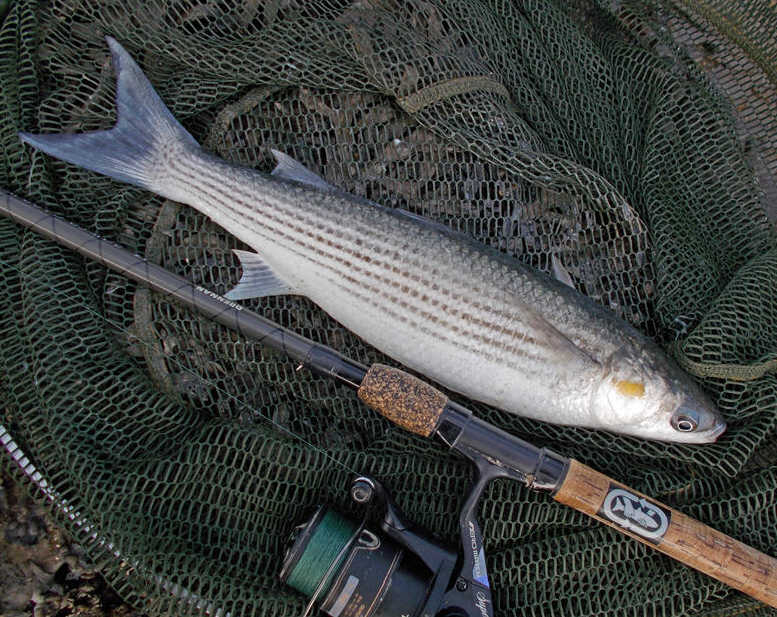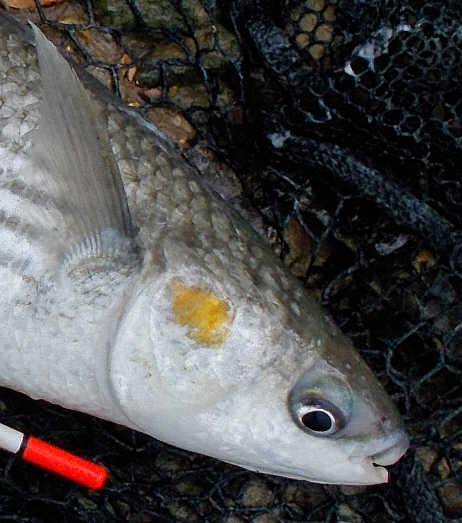|
With the (arguably) improved communications afforded by social media and the internet in general, there are an increasing number of
reports of large golden-greys being captured. Sadly, the supporting photographs almost always do very little to confirm the ID, one way or another.
Here are some checks and photo suggestions which are intended to supplement the information contained in the
'mullet ID' page.
1. Examination
The 'quick route' is to say that if it looks like the two photos at the bottom of this page, then it's a golden-grey. The 'quick route' is to say that if it looks like the two photos at the bottom of this page, then it's a golden-grey. Otherwise, please note: the features described next are typical of the majority of specimens of each of the mullet species, but each individual identifier may or may not be present; it is probably the presence of a number of positive identifying factors and the absence of negating factors
which will give the best level of confidence that a correct identification has been made.
| Check |
Result |
Notes and Caveats |
Does it have papillae
('warts') on the upper lip? Does it have papillae
('warts') on the upper lip? |
Y
|
It's a thicklip; very few thicklips lack papillae, and
they are not present in the other two species.
|
|
Does it have a notably thick upper lip?
|
Y
|
It's a thicklip.
|
|
Is it particularly slimy, especially when out of the water for a short while?
|
Y
|
It may be a golden-grey; other species also produce slime, but usually to a much lesser extent than a
golden-grey.
|
|
Is the pectoral fin notably
curved / scimitar-shaped?
|
Y
|
It may be a golden-grey; this is often a feature of that species, but NB, some golden-greys do not have fins
that are particularly like this, bearing very little difference to the fins on a thicklip. Sometimes, a photograph can suggest a curve, purely due
to the position of the fin, so it's important to look at the actual fish prior to release.
|
|
If the pectoral fin is folded gently forward,
does it cross the margin of the eye?
|
Y
|
It may be a golden-grey; this is also listed in the British Sea Fishing ID guide as being an indicator for
golden-greys, stating "Another identifying factor are the pectoral fins which are longer than in the above two species and will reach the
eyes".
|
|
Does it have a gold spot on the
gill cover?
|
Y
|
It may be a golden-grey, but the other species can also have gold markings on the gill cover, and these are
present on a significant number of thicklips; it is sometimes vastly
reduced or even absent in golden-greys. This ID feature is generally considered to be unreliable, if taken
purely in isolation.
|
|
Does it have small teeth on the
upper lip?
|
Y
|
It may be a golden-grey; note that thinlips are also said to have small teeth, but these are absent in thicklips.
|
|
Does it have a black spot at the base of
the pectoral fin?
|
Y
|
It is very possibly a thinlip, but NB not all thinlips have the suggestion of a
black spot.
|
|
Does it have a strong gold or orange tint in the
eye?
|
Y
|
It is very possibly a thinlip, but NB there may be some degree of colour / tinting in the other species.
|
|
Is the jugular space fairly narrow, and fairly straight?
|
Y
|
It is very probably a thicklip, as the jugular space
is larger in both of the other two species.
|
|
2. Photography and Verification
To verify your catch later, preferably after it's been safely released, a good photograph of the head will greatly assist.
In short, try to get a couple of photos that look something like these, both a full-body image, and particularly, an image that clearly shows the
pectoral fin, head and lips.
|
|
Resources - but please note that some misleading information is present in the non-NMC websites:
National Mullet Club ID Guide
British Sea Fishing
Planet Sea Fishing
|
|
|



